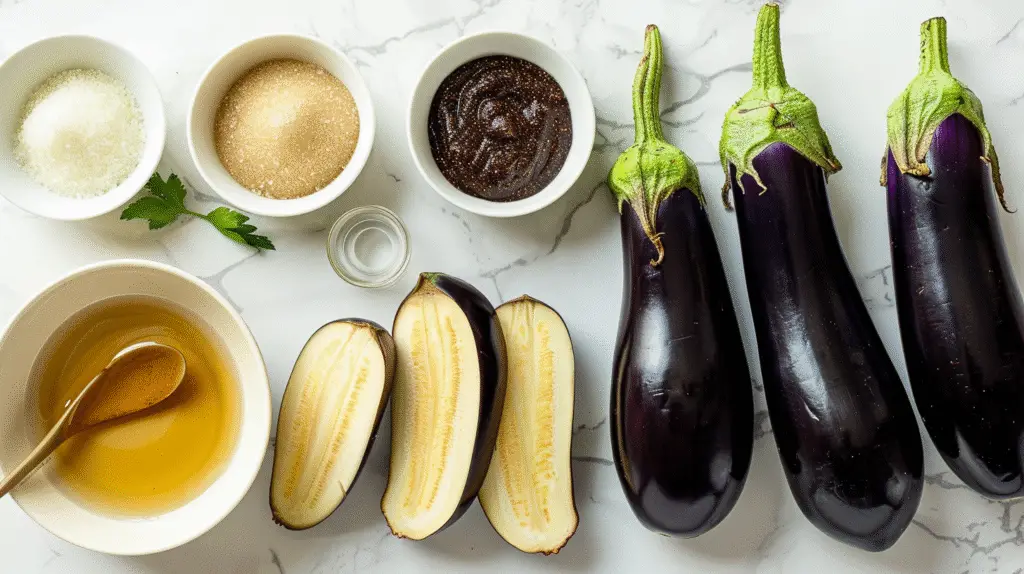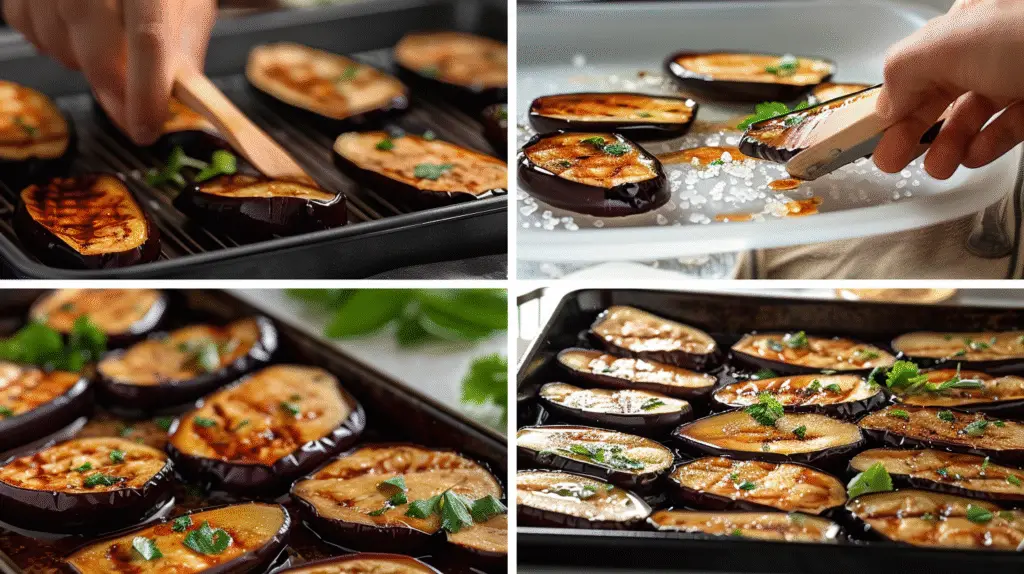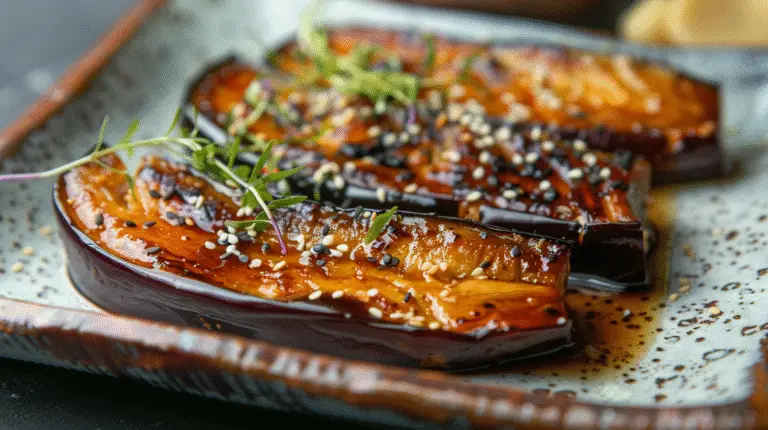Miso Glazed Eggplant Slices (Nasu Dengaku): A Savory Japanese Classic
Introduction
A Taste of Tradition: The Story Behind Miso Glazed Eggplant 🇯🇵
Delicate, savory, and beautifully caramelized, Miso Glazed Eggplant Slices — known in Japanese as Nasu Dengaku — are a traditional side dish with roots that stretch back over 1,200 years. This dish originated during the Heian period (794–1185), when it was first prepared as a temple offering, using miso, a fermented soybean paste, for its rich umami character.
The term dengaku initially referred to skewered tofu grilled and topped with miso, resembling dancers in ceremonial garb performing rice planting rituals. Over time, this evolved to include other grilled foods like eggplant, especially during seasonal festivals. Today, Nasu Dengaku is a beloved staple in Japanese cuisine, appearing on home tables, izakaya menus, and bento boxes alike.
A Global Classic, Reimagined for Modern Kitchens 🍆
While the original preparation involved open-flame grilling and thick miso glazes, modern versions are oven-roasted, broiled, or even air-fried, making them more accessible for home cooks around the world. The key elements remain: tender eggplant, a deeply flavorful miso glaze, and the perfect finishing touch — a quick broil to bubble and caramelize the surface.
Whether you’re diving into Japanese cuisine for the first time or looking to elevate your vegetable sides, this easy miso-glazed eggplant recipe delivers elegance, history, and flavor in every bite.
What You’ll Need
Essential Tools for Perfectly Glazed Eggplant 🔪🍆
Making Nasu Dengaku at home is refreshingly simple — especially when you have the right tools. These basic kitchen items will help you prep, glaze, and serve with ease:
-
A baking sheet or grill pan for roasting the eggplant evenly.
-
Mixing bowls to whisk together your miso glaze ingredients.
-
A basting brush to apply the glaze precisely and generously.
-
A sharp knife and cutting board for slicing and scoring the eggplant.
These tools help ensure your eggplant turns out tender inside and caramelized on top, a hallmark of great Japanese side dishes.
Optional Equipment for Extra Ease 🛠️
-
A broiler gives the top of your eggplant that classic bubbly, charred finish — just like you’d find at a Japanese izakaya.
-
Prefer a healthier twist? An air fryer can cook the eggplant quickly while keeping oil usage low.
-
For larger batches or entertaining, a cooling rack on a baking sheet helps promote even airflow and prevent sogginess.
Looking to up your veggie game in the kitchen? Don’t miss our guide on Best Practices for Storing Cooked Vegetables — a great resource for keeping dishes like this fresh and flavorful.
Ingredients

Simple Ingredients, Big Umami Flavor 🍶🍆
Miso Glazed Eggplant Slices are built around a handful of ingredients that are easy to find in any Asian grocery store — or even your local market. The key is quality, especially when it comes to the miso paste and oil.
For the Eggplant
-
2 medium Japanese eggplants, sliced lengthwise
-
1 tablespoon vegetable oil
-
Pinch of salt
Japanese eggplants are ideal for this recipe because of their thin skin and mild flavor, but you can also use Chinese eggplants or small globe eggplants in a pinch. Salt helps draw out moisture, making the texture extra tender after roasting.
For the Miso Glaze
-
3 tablespoons white miso paste
-
1 tablespoon mirin (Japanese sweet rice wine)
-
1 tablespoon sake
-
1 tablespoon sugar
-
1 teaspoon sesame oil
This glaze is the heart of the dish — sweet, salty, nutty, and rich in umami. White miso (shiro miso) is preferred for its milder taste, which lets the eggplant shine.
Want to learn more about how to choose and use miso in your dishes? Check out our Homemade Miso Paste Guide to dive deeper into flavor profiles and substitutions.
Instructions

Step 1: Prep the Eggplant for Maximum Flavor 🍆
Start by slicing your Japanese eggplants in half lengthwise. Using a sharp knife, score the flesh in a crosshatch pattern — this helps the glaze seep into every bite and prevents the eggplant from curling as it cooks.
Sprinkle each half with a pinch of salt and let them rest for 15 minutes. This draws out excess moisture and softens the flesh, resulting in a more tender final dish. Once rested, pat them dry thoroughly with paper towels.
Step 2: Roast or Grill the Eggplant 🔥
Brush the eggplant slices with vegetable oil on both sides. Lay them flesh-side up on a baking sheet or grill pan.
Roast in a preheated 400°F (200°C) oven for 20 minutes, or until the eggplant is fork-tender and lightly browned. Alternatively, you can grill the slices for slightly smokier flavor.
Step 3: Whisk the Miso Glaze 🥄
While the eggplant cooks, combine the following in a small bowl:
-
3 tbsp white miso paste
-
1 tbsp mirin
-
1 tbsp sake
-
1 tbsp sugar
-
1 tsp sesame oil
Whisk until smooth and glossy. The mixture should be pourable but thick enough to coat the eggplant.
Step 4: Glaze and Broil Until Caramelized ✨
Once the eggplant is cooked, remove from the oven and brush each slice generously with the miso glaze. Set your oven to broil, and return the tray for 2–3 minutes. Keep a close eye — you want bubbling caramelization, not burning!
Finish with a sprinkle of sesame seeds or scallions, and serve hot.
Need more tips for getting that perfect glaze finish? Check out our Tips for Perfectly Glazed Vegetables for expert tricks.
Nutrition Score
Plant-Based, Umami-Packed, and Nutrient Dense 💪🌿
Don’t let the rich flavor fool you — Miso Glazed Eggplant Slices are a healthy and satisfying side dish. They pack a punch of fiber, antioxidants, and fermented goodness, making them a smart choice for balanced eating.
Here’s why this recipe shines nutritionally:
-
Eggplant is low in calories and high in fiber, supporting digestion and fullness. It also contains nasunin, an antioxidant that may help protect brain cells.
-
Miso provides a savory dose of plant-based protein, B vitamins, and probiotics, which promote gut health and immune support.
-
Sesame oil adds healthy fats and flavor with just a small amount.
Combined, this dish gives you the best of both worlds — deep umami flavor and plant-forward nutrition.
Estimated Nutritional Info (Per Serving) 🧾
-
Calories: 180
-
Protein: 4g
-
Carbohydrates: 20g
-
Fat: 9g
-
Fiber: 5g
-
Sodium: ~600mg
Note: Values may vary depending on the miso brand and eggplant size used.
Looking to explore more health-conscious Asian dishes? Try our high-fiber Sweet Potato and Black Bean Salad — it’s a perfect plant-based main to complement this flavorful side.
Variations & Additions
Flavor Twists to Keep It Interesting 🔄🌶️
While traditional Nasu Dengaku is a classic, there’s plenty of room to customize and explore flavor profiles to suit your taste. Here are a few creative ideas:
-
Spicy Kick: Add a pinch of shichimi togarashi or a few drops of chili oil to your miso glaze for a subtle, warming heat.
-
Sweeter Touch: For a more mellow, balanced flavor, try substituting brown sugar or maple syrup in place of white sugar.
-
Citrusy Brightness: A splash of yuzu juice or a zest of lime can cut through the richness of the glaze with a pop of acidity.
-
Herbal Notes: Add a little grated ginger or top with fresh cilantro for a fusion-friendly twist.
These additions help you adapt the recipe to match seasonal ingredients or the rest of your menu.
Looking for another unique veggie-based appetizer? Check out our Everything Bagel Roasted Cauliflower — it’s another unexpected twist on a classic.
Diet-Friendly Modifications ✅
This dish is already vegetarian and can be easily adjusted for other dietary needs:
-
Gluten-Free: Use gluten-free white miso and ensure your mirin and sake are certified gluten-free (or substitute with rice vinegar and water).
-
Low-Sodium: Reduce miso quantity slightly and increase mirin or sugar to balance the glaze without overpowering saltiness.
-
Vegan Option: Most miso is naturally vegan, but double-check the label (some versions include fish-derived dashi). All other ingredients are already plant-based.
By making just a few tweaks, this dish can fit seamlessly into any meal plan or preference — without losing its savory-sweet charm.
FAQs
What type of miso works best for miso-glazed eggplant? 🍥
White miso (shiro miso) is ideal for this dish due to its light, slightly sweet flavor that complements the eggplant without overpowering it. You can also use red miso (aka miso) for a bolder, saltier flavor — just reduce the quantity slightly to avoid over-seasoning.
Can I grill, roast, or air-fry the eggplant slices? 🔥
Yes, and each method brings its own benefit:
-
Grilling adds a wonderful smokiness to the flesh.
-
Roasting is convenient and ideal for achieving a creamy texture inside.
-
Air frying cuts down on oil and results in beautifully browned edges.
Choose the method that fits your setup and dietary preferences.
How do I prevent the eggplant from becoming soggy? 💧
Scoring the flesh and salting the slices before cooking is crucial. This draws out moisture and prevents the eggplant from steaming as it roasts. Also, make sure to pat the slices dry thoroughly before applying oil or glaze.
Is miso-glazed eggplant a traditional Japanese recipe? 🇯🇵
Yes! Known as Nasu Dengaku, this dish is deeply rooted in Japanese food culture, dating back to the Heian period (794–1185). It’s a staple in both traditional temple cuisine and modern izakaya menus — valued for its umami-rich flavor and elegant presentation.
Still curious about other classic Japanese sides? Try our Cucumber Tomato Feta Salad for a refreshing, fusion-inspired pairing.
Conclusion
A Sweet-Savory Masterpiece Rooted in Japanese Tradition 🍆✨
From its origins in Heian-era Japan to modern kitchen tables worldwide, Miso Glazed Eggplant Slices offer a perfect balance of flavor, nutrition, and simplicity. The tender eggplant, deeply scored and roasted, soaks up every drop of the rich miso glaze, which bubbles into a caramelized coating under the broiler. The result? A vegetarian Japanese side dish that tastes like comfort food but feels like fine dining.
This dish is proof that a handful of quality ingredients — miso paste, mirin, sake, and sesame oil — can transform humble vegetables into something truly special. It’s ideal for both casual weeknights and beautifully plated dinner parties.
Whether you’re new to Japanese cooking or already love exploring plant-based recipes, Nasu Dengaku delivers depth, tradition, and elegance in every bite.
📸 Show Us Your Nasu Dengaku!
Have you made this recipe or added your own twist?
👉 Tag us @donaldrecipes on Instagram or leave a comment below.
📝 Want to inspire others? Share Your Miso Glazed Eggplant Creations — we might feature your version!

